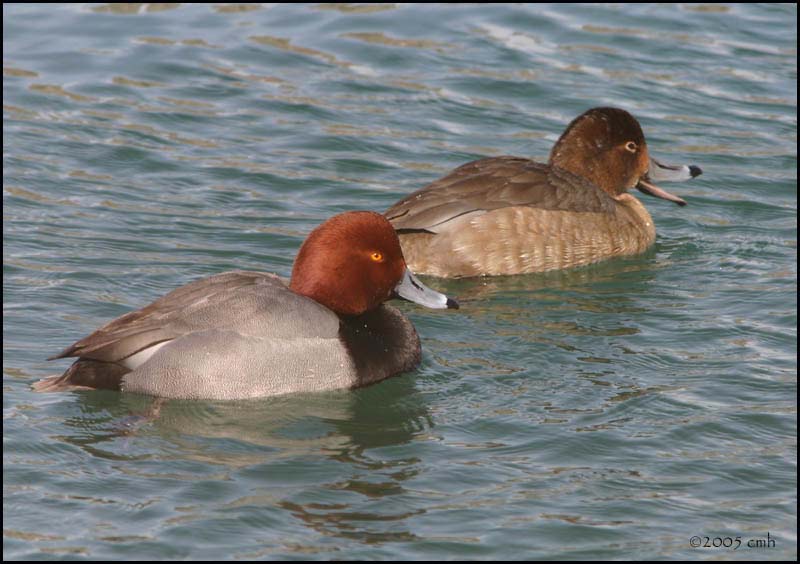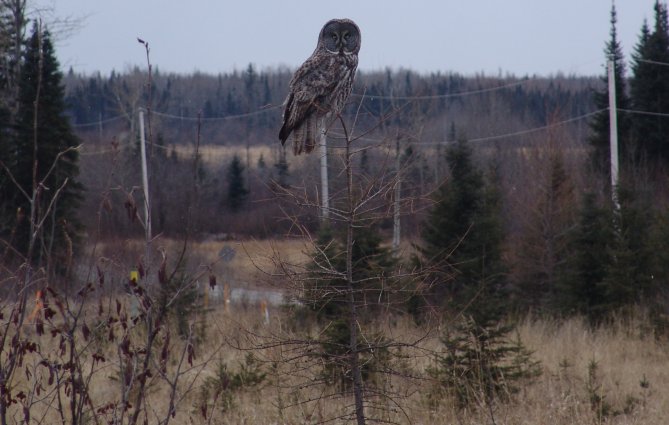By Ron Pittaway
This article first appeared in OFO NEWS 12: 3, October 1994 and was updated in July, 2001. Posted 8 September 2006 to Ontbirds and BirdChat. Revised 14 September 2006.
This article first appeared in OFO NEWS 12: 3, October 1994 and was updated in July, 2001. Posted 8 September 2006 to Ontbirds and BirdChat. Revised 14 September 2006.
Which laws protect birds? What is prohibited? Who enforces bird laws? What are the penalties? In Canada, jurisdiction over birds is divided between the federal and provincial governments. Here is a summary of the federal and provincial laws that protect and regulate the use of birds in Ontario.
Please contact Ron if you have further questions. Ron Pittaway, 9 Lichen Place, Toronto ON M3A 1X3, or
This is the most important law protecting birds in Canada. Most birds in Ontario are protected by this Act. The Migratory Birds Convention Act (MBCA) was completely updated for the first time in June 1994. The new Act strengthens the enforcement provisions and significantly increases the penalties. The original MBCA was passed in 1917 to meet the terms of an agreement signed with the United States to protect birds such as waterfowl and shorebirds, which were being subjected to uncontrolled hunting. Also included were “good” birds such as most songbirds, considered beneficial to humans because they eat insects and weed seeds. However, birds deemed at that time to be vermin or harmful to humans such as hawks, owls, crows and cormorants were left under provincial jurisdiction.
The name “Migratory” is somewhat misleading because some migratory birds like the Merlin are not protected by the MBCA while some non-migratory species like the Downy Woodpecker are! The birds covered by the MBCA in Ontario are: loons, grebes, shearwaters, fulmars, storm-petrels, gannets, anhingas, herons, bitterns, ibises, storks, swans, geese, ducks, rails, gallinules, coots, cranes, shorebirds, jaegers, gulls, terns, skimmers, alcids, pigeons, doves (except Rock Dove), cuckoos, goatsuckers, swifts, hummingbirds, woodpeckers, tyrant flycatchers, larks, swallows, titmice, chickadees, nuthatches, creepers, wrens, kinglets, gnatcatchers, thrushes, mockingbirds, thrashers, catbirds, pipits, silky-flycatchers, shrikes, vireos, wood warblers, tanagers, cardinals, sparrows, buntings, meadowlarks, bobolinks, orioles and finches. The MBCA generally does not protect introduced species such as the European Starling and House Sparrow. See the Fish and Wildlife Conservation Act (Ontario) for birds regulated by the province.
Except under the authority of a permit, the MBCA prohibits the hunting, collecting, trapping, mist-netting and banding of birds, the collecting of eggs and nests, the possession of birds found dead, and the keeping of captive birds. Permits to possess or collect migratory birds are issued by the Canadian Wildlife Service (CWS) but these permits are virtually impossible for an individual to obtain. However, permits are issued to agencies that work with birds such as the Ministry of Natural Resources (MNR), Canadian Museum of Nature, Royal Ontario Museum and universities. Hunters may possess or have their migratory gamebirds mounted by a taxidermist under the authority of their Migratory Bird Hunting Permit. Taxidermists must have a permit from the CWS for migratory birds. Permission for the collection or possession of provincially regulated birds for educational and scientific purposes comes from the MNR The MNR also issues possession permits for provincial birds that died of natural causes or were killed accidentally.
The MBCA regulates the hunting of ducks, geese, rails, American Coot, Common Moorhen, American Woodcock and Common Snipe in Ontario. Regulations governing open seasons and possession limits of migratory gamebirds are set each year. There is no hunting season for Harlequin Duck in Ontario. The decision to close the season was based on recommendations by the MNR and CWS because of its low numbers.
Enforcement of the MBCA in Ontario is handled jointly by the CWS, MNR and RCMP. The maximum penalties are: (1) for a corporation a $250,000 fine and (2) for an individual a $100,000 fine or imprisonment for five years or both.
An excellent publication entitled “Birds Protected in Canada Under the Migratory Birds Convention Act ” is available free. Write to: Publications, Canadian Wildlife Service, Ottawa ON K1A 0H3 or phone (819) 997-1095.

Redhead
Female at back
Photo: Carol Horner
.jpg)
Northern Pintail
Female below
Photo: Sam Barone

Rose-breasted Grosbeak
Female
Photo: Frank and Sandra Horvath
Ontario's Endangered Species Act (ESA) currently protects 11 species of birds and their habitats in Ontario: American White Pelican, Bald Eagle, Golden Eagle, Peregrine Falcon, King Rail, Piping Plover, Eskimo Curlew, Loggerhead Shrike, Kirtland's Warbler, Prothonotary Warbler and Henslow's Sparrow. Under the ESA, it is prohibited to wilfully kill, injure or interfere with an endangered species, or to interfere with or destroy the habitat of an endangered species. Note that the habitat of an endangered species is also protected! The key word in this Act is “wilfully”. Therefore to obtain a conviction, the Crown must prove that the defendant acted intentionally.
Conservation Officers with the MNR are chiefly responsible for enforcement. A person convicted under the ESA “is liable to a fine of not more than $50,000 or to imprisonment for a term of not more that two years, or to both”. There is no federal Endangered Species Act in Canada, but one is under consideration.
In addition, the national Committee on the Status of Endangered Wildlife in Candada (Cosewic) lists Northern Bobwhite, Barn Owl, and Acadian Flycather as endangered in Ontario but this gives them no extra protection.

Bald Eagle
Immature
Photo: Ken Newcombe
This Ontario law generally applies only to those birds not covered by the federal MBCA. Birds protected by the Fish and Wildlife Conservation Act (FWCA) are: pelicans, cormorants, vultures, ospreys, kites, eagles, hawks, caracaras, falcons, partridges, pheasants, grouse, ptarmigan, turkey, quail, owls, kingfishers, jays, nutcrackers, magpies and ravens. The FWCA does not protect the following six birds or their nests and eggs in most of Ontario: American Crow, Brown-headed Cowbird, Common Grackle, Red-winged Blackbird, European Starling, and House Sparrow. However, the Act does protect these six birds in provincial parks and provincial crown game preserves. Rock Doves are also not protected because they are introduced domesticated birds gone feral. However, one must have a hunting licence to hunt even unprotected birds. In addition, the FWCA regulates the seasons and limits of gallinaceous birds; that is, partridge, pheasant, grouse, ptarmigan, turkey and quail, which may be hunted with a provincial hunting licence. Interestingly, the FWCA allows the killing of birds, except birds protected by the MBCA and the ESA, in defence of property. For example, farmers do not need a permit to kill a hawk attacking their chickens.
The FWCA prohibits the hunting, trapping and collecting of birds without the proper licence or scientific permit. Importantly, the use of poison to kill birds is strictly prohibited. Furthermore, the Act prohibits the taking or possession of eggs and nests of those species protected by the Act without a permit.
You may possess birds (but not birds protected by the MBCA) found dead that were killed by natural or accidental causes. In general, dead birds in your possession must be reported to the MNR within five working days, except birds of prey, which must be taken to the MNR for inspection within two working days. For example, if you find a dead owl hit by a car, the MNR may issue you a permit to keep the bird or to have it mounted by a taxidermist, provided an inspection shows the bird died accidentally or of natural causes. However, hunters may have their gallinaceous gamebirds mounted under the authority of their provincial hunting licence.
Enforcement of the FWCA is done mainly by Conservation Officers employed by the MNR. The general penalty is a fine of not more than $25,000, to imprisonment for a term of not more than one year, or both.

Great Gray Owl
Photo: Marc Johnson
Keeping of wildlife in captivity is generally prohibited under the FWCA but the use of birds of prey for falconry is an exception. To hunt provincially regulated game animals, falconers require both a falconry licence and a provincial Small Game Hunting Licence and must follow the hunting limits. A federal Migratory Bird Permit is also required to hunt federally regulated birds such as ducks.
These 16 species of indigenous birds need a falconry license: Bald Eagle, Northern Harrier, Sharp-shinned Hawk, Cooper‘s Hawk, Northern Goshawk, Red-shouldered Hawk, Broad-winged Hawk, Red-tailed Hawk, Golden Eagle, American Kestrel, Merlin, Gyrfalcon, Peregrine Falcon, Great Horned Owl, Northern Hawk Owl and Snowy Owl. These 12 birds do not need a falconry licence: Tawny Eagle, Steppe Eagle, Bonelli‘s Eagle, European Sparrow Hawk, Swainson‘s Hawk, Harris's Hawk, Ferruginous Hawk, European Kestrel, Saker Falcon, Lagger Falcon , Lanner Falcon, and Prairie Falcon. Other raptors may be possessed in Ontario, but they may not be used for hunting.
All falconry birds must be banded and falconers must keep a log book and submit annual reports to the Ministry of Natural Resources. New falconers must get a training license and take instruction. To advance from training to a general license you have to have kept a bird of prey for at least two years in the past five years. Breeding requires a commercial license and a Small Game Hunting License. Other rules govern non-residents bringing birds of prey into Ontario. Capturing wild birds is not allowed, though the use of injured and nuisance birds may sometimes be authorized.

Merlin
Nestlings
Photo: John Millman
The eight species are: American White Pelican, Belted Kingfisher, Gray Jay, Blue Jay, Comon Raven, Rusty Blackbird, Brewer‘s Blackbird and Yellow-headed Black bird. You cannot hunt or trap these birds or any other birds wild by nature and not a game bird. Nor can you take their nests or eggs.
American Crow, Brown-headed Cowbird, Common Grackle, Red-winged Blackbird, European Starling, and House Sparrow are not protected under the act, however, they and their nests and eggs are protected in both provincial and national parks.
Hunting of the following nine game birds is regulated by the act: Gray Partridge, Ring-necked Pheasant, Spruce Grouse, Willow Ptarmigan, Rock Ptarmigan, Ruffed Grouse, Sharp-tailed Grouse, Wild Turkey, and Northern Bobwhite. Hunting of ducks, geese, woodcock, snipe and rails is regulated federally.
National parks such as Point Pelee are administered by the Canadian Parks Service. All birds in national parks are fully protected by the National Parks Act (NPA). Species such as crows, blackbirds, starling and House Sparrow that are not protected by law elsewhere, are given full protection by the NPA. Duck hunting was last permitted in Point Pelee National Park in 1988. Enforcement of the NPA is the responsibility of federal Park Wardens and the RCMP. The penalty is a fine of up to $2000 or six months imprisonment or both. Four species are given special protection in national parks: Whooping Crane, Piping Plover, Peregrine Falcon and Gyrfalcon, and the penalty increases to $150,000.
Provincial parks such as Algonquin and Presqu'ile are administered by the MNR. The Provincial Parks Act does not protect birds. Nevertheless, all birds in provincial parks are fully protected by the MBCA, the FWCA and the ESA. Birds like crows, cowbirds and House Sparrows that are not protected elsewhere are protected in provincial parks and Crown game preserves by the FWCA. However, waterfowl hunting is permitted in some provincial parks such as Presqu'ile and Darlington subject to regulations made under the FWCA and MBCA. Enforcement in provincial parks is the responsibility of provincial Park Wardens, Conservation Officers and the Ontario Provincial Police.
It is a criminal offence to wilfully and without lawful excuse kill, maim, wound, poison or injure a bird, or for anyone to cause or permit unnecessary pain, suffering or injury to a bird. Both wild and domestic birds are protected. Enforcement of criminal offences related to birds is the responsibility of the police and humane societies. The penalty is a fine of not more than $2000 or to imprisonment for six months or both.

Rusty Blackbird
Photo: Sam Barone